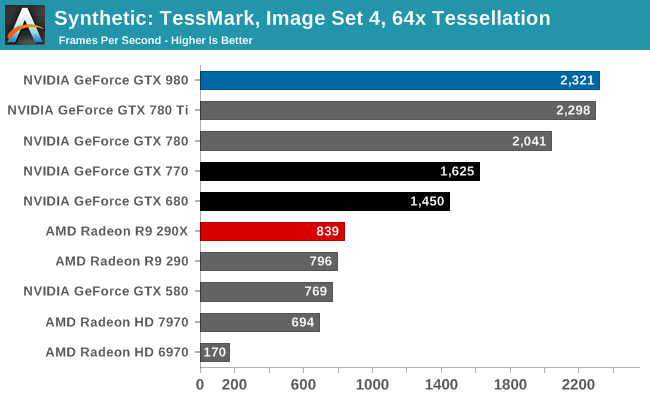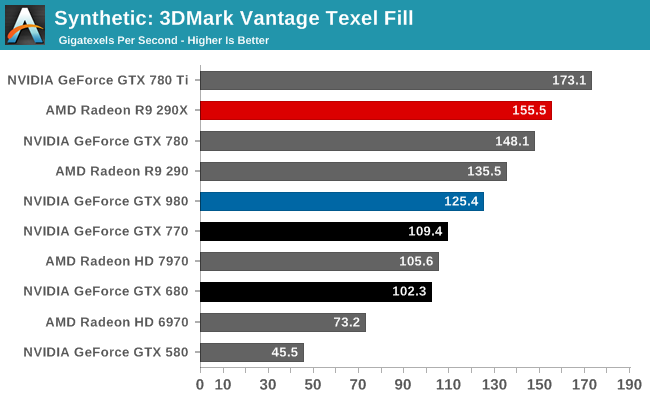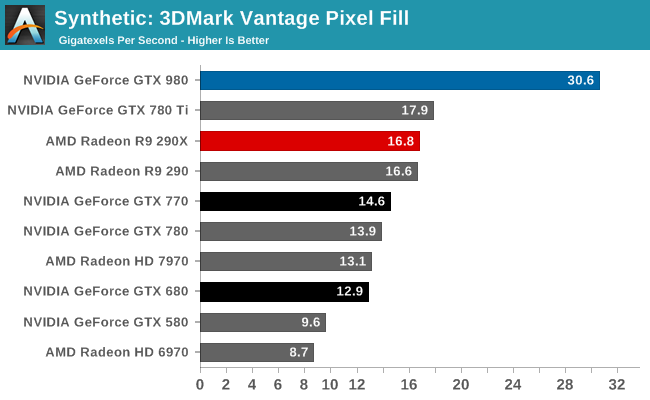The NVIDIA GeForce GTX 980 Review: Maxwell Mark 2
by Ryan Smith on September 18, 2014 10:30 PM ESTSynthetics
As always we’ll also take a quick look at synthetic performance. These tests mainly serve as a canary for finding important architectural changes, and with the exception of pixel throughput we are not expecting any major changes for GTX 980 and GM204.

GM204 is designed to have an ever-so-slightly higher triangle throughput rate than GK110 – 16 tris/clock versus 15 tris/clock, and sure enough the GTX 980 comes out on top in TessMark, slightly edging out the GTX 780 Ti. The difference is only very slight here, and though GM204 should be a bit more powerful than GK110 in practice it’s a dead heat.
Moving on, we have our 3DMark Vantage texture and pixel fillrate tests, which present our cards with massive amounts of texturing and color blending work. These aren’t results we suggest comparing across different vendors, but they’re good for tracking improvements and changes within a single product family.

Beginning with Maxwell NVIDIA reduced their texture-to-compute ratio from 12:1 to 16:1. As a result of this change Maxwell GPUs have fewer texture units than comparable Kepler GPUs. Compounding this effect is the fact that Maxwell CUDA cores are more efficient than Kepler CUDA cores, leading to NVIDIA placing fewer cores overall and further reducing the texture fill rate.
As a result the GTX 980 is not texture fillrate competitive with any of the GK110 cards. It is competitive with the GK104 cards, but only because these cards had the same number of texture units at 128. NVIDIA has told us that they believe this new ratio is a better fit for modern workloads, and judging from the performance we’re seeing elsewhere it would appear that NVIDIA is right.

On the other hand, thanks to NVIDIA’s newer 3rd generation delta color compression technology, our 3DMark pixel fillrate performance is through the roof. GTX 980 comes very close to doubling the throughput of our GK110 cards and more than doubles the throughput of the GK104 cards, reflecting the fact that it has 64 ROPs and more importantly has the available bandwidth to put them to good use.
This benchmark in a nutshell is why NVIDIA can deliver chart-topping performance despite having only 2/3rds the memory bandwidth of GTX 780 Ti. By improving their color compression to this point, NVIDIA can significantly reduce their memory bandwidth requirements Maxwell 2, allowing them to do more with less. In real games the result won’t be anywhere near this remarkable since this is a pure pixel fillrate test, but it goes to show that NVIDIA has been able to expand their effective memory bandwidth in concert with their ROP and shader performance improvements.










274 Comments
View All Comments
Viewgamer - Friday, September 19, 2014 - link
To Ryan Smith. How can the GTX 980 possibly have a 165W TDP when it actually consumes 8 watts more than the 195W TDP GTX 680 !? please explain ? did Nvidia just play games with the figures to make them look more impressive ?ArmedandDangerous - Friday, September 19, 2014 - link
TDP =/= Power consumption although they are related. TDP is the amount of heat it will output.Carrier - Friday, September 19, 2014 - link
You're right, power consumption and heat output are related. That's because they're one and the same! What else could that electricity be converted to? Light? A massive magnetic field? Mechanical energy? (The fan, slightly, but the transistors aren't going anywhere.)Laststop311 - Friday, September 19, 2014 - link
no they aren't the same. Not all the electricity used is converted to heat. This is where the word EFFICIENCY comes into play. Yes it is related in a way but maxwell is more efficient with the electricity it draws using more of it and losing less of it to converted heat output. It's all in it's design.bernstein - Friday, September 19, 2014 - link
bullshit. since a gpu doesn't do chemical nor mechanical transformations all the energy used is converted to heat (by way of moving electrons around). efficiency in a gpu means how much energy is used for a fixed set of calculations (for example: flops)Senpuu - Friday, September 19, 2014 - link
It's okay to be ignorant, but not ignorant and belligerent.bebimbap - Friday, September 19, 2014 - link
there is "work" being done, as transistors have to "flip" by use of electrons. Even if you don't believe that "input energy =\= output heat" think of it this way100w incandescent bulb produces X amount of useful light
18w florescent bulb also produces X amount of useful light
in this sense the florescent bulb is much more efficient as it uses only 18w to produce the same light as the 100w incandescent. so if we say they produce the same amount of heat, then
100w florescent would produce ~5x the light of a 100w incandescent.
Laststop311 - Saturday, September 20, 2014 - link
ur so smart broGuspaz - Friday, September 19, 2014 - link
The power draw figures in this article are overall system power draw, not GPU power draw. Since the 980 offers significantly more performance than the 680, it's cranking out more frames, which causes the CPU to work harder to keep up. As as result, the CPU power draw increases, counteracting the benefits of lower GPU power draw.Carrier - Friday, September 19, 2014 - link
I don't think that can explain the whole difference. It performs similarly to a 780 Ti in Crysis 3, so the difference in power consumption can only come from the card. The 980 is rated 85W less in TDP but consumes only 68W less at the wall. The discrepancy gets worse when you add losses in the power supply.My guess is the TDP is rated at nominal clock rate, which is cheating a little because the card consistently runs much higher than nominal because of the boost.